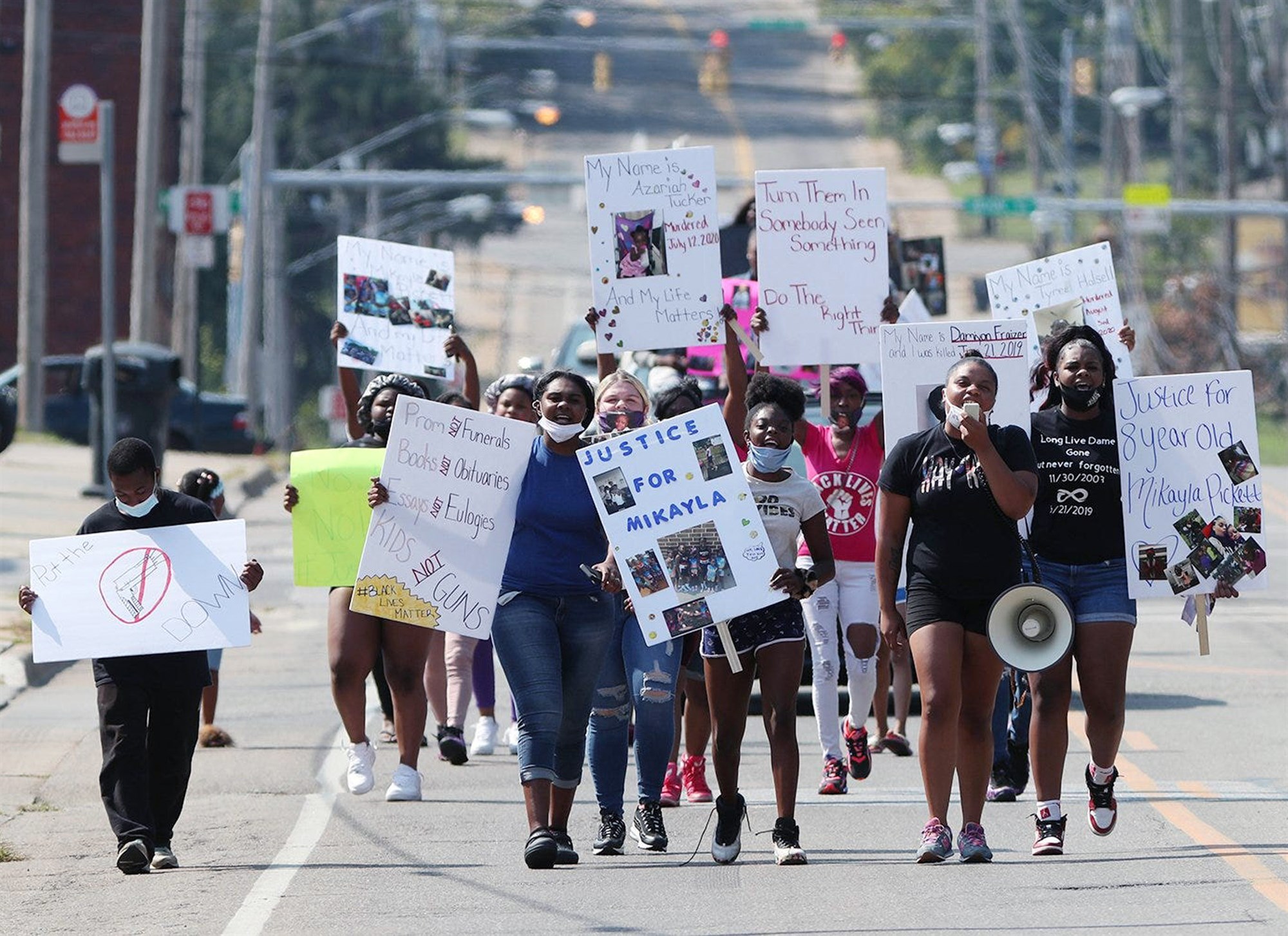Shortly after 3:30 p.m. on Aug. 14, Shoskamika Risper said goodbye to her daughter, Mikayla, before leaving their Akron, Ohio, home for her job at a nearby KFC restaurant.
“I love you, and I’ll see you later,” Risper told her.
“I love you, too,” the 8-year-old replied.
About eight hours later, as Risper was finishing up her shift, her phone rang. It was her teenage son. He was hysterical.
Mikayla had been shot at a birthday party for one of the kids around the block, he told her. One of the bullets fired into the neighbor’s backyard had slammed into Mikayla’s back.
The soon-to-be third-grader, known by her school principal for her “brilliant sense of humor, energetic hugs and kind spirit,” was pronounced dead overnight. Risper received the news in the hospital waiting room, still wearing her KFC uniform.
“It’s devastating,” Risper said. “She had her whole life to live.”
Homicides rose sharply across the country, in cities big and small, in 2020.
Kansas City, Missouri, broke its previous record-high year for homicides in October. The number of killings in Fort Wayne, Indiana, more than doubled. Los Angeles reached its own milestone in November: more than 300 homicides for the first time in over a decade.
In Akron, the bloodshed has taken a particularly painful toll.
Violent crime isn’t new for this industrial city of nearly 200,000 in northern Ohio, but far more children lost their lives to gun violence in 2020 than in years past, police officials said.
Over a single four-month stretch, a total of six children under the age of 16 were killed. All but one died from gunfire.
“They’re innocent people who haven’t had a chance to get a start in life,” Akron police Capt. David Laughlin said. “And it seems to hit harder for the community. It hits harder for the officers.”
The killings have shaken the city, sparking a series of anti-violence demonstrations and prompting Mayor Dan Horrigan to launch a plan to hire 12 additional police officers dedicated to curbing gun violence.
The Rev. Roderick Pounds, pastor of the Second Baptist Church, said the bloodshed has also spurred increasing numbers of Akron residents, particularly Black mothers, to arm themselves.
“There’s a lot of angst in the community,” said Pounds, who leads monthly concealed weapons training courses.
Pounds said his classes have ballooned over the last year, with Black women accounting for 80 percent of the participants.
“The irony is we’re arming ourselves against ourselves,” Pounds said. “It’s so sad, but that’s what’s happening more and more.”

Homicides have soared in both Republican-led cities like Tulsa, Oklahoma, and Fort Worth, Texas, as well as larger, Democratic-run urban centers like New York and Chicago.
Jeff Asher, a New Orleans-based crime analyst, has been chronicling the crime data from 57 cities with populations over 250,000 people. Murders are up 36 percent through at least September compared to 2019, he said.
“It’s not as bad as it was in the 1980s and early 1990s, but I’m not sure it’s fair to compare it to the worst period in modern history,” said Asher, a former CIA analyst.
The Covid-19 crisis has impacted all facets of society: torpedoing businesses, erasing jobs, emptying out schools, short-staffing police departments and disrupting the court and jail systems.
It’s difficult to pinpoint why homicides surged across the U.S. this year, but criminologists and other experts say those pandemic side effects are all likely contributing factors.
UCLA professor Jorja Leap said changes in people’s routine punctuated by economic upheaval, job loss, distance learning and other factors also brought individuals into closer contact for sustained periods, heightening tensions and increasing the prospect of violent encounters. At the same time, gun sales spiked, teenagers were out of school and organized activities and programs ground to a halt.
“This is a complex situation with Covid at its heart but with several social dilemmas all interacting with each other,” said Leap, a professor of social welfare. “I’m actually surprised there hasn’t been more of a rise in crime.”
James Alan Fox, a professor of criminology at Northeastern University, said the combination of a cratering economy and cooped-up young people with even fewer opportunities provides an opening for gangs to exploit.
“You have a lot of teenagers and young adults who recognize that they’re not working — no one’s hiring,” Fox said. “And what opportunity is there? But gangs are always hiring.”
Other experts pointed to the fallout from the death of George Floyd, who was killed in Minneapolis police custody.
Chuck Wexler, executive director of the Police Executive Research Forum, noted that police departments in several American cities were faced with escalating demonstrations and heightened scrutiny of their conduct in the wake of Floyd’s death.
The protests forced already-strained departments to redeploy officers in places like Seattle and Portland, Oregon, which both saw a sharp rise in homicides.
“They were spread thin,” Wexler said. “They weren’t able to have the usual complement of officers in some parts of the city, and, honestly, police became more cautious about engaging with the public.”
“You’ve got this whole Covid-19 issue and concerns about police use of force,” he added. “All of those ingredients, I think, made for a very difficult summer in American cities.”

Akron eclipsed its previous record-high year for homicides in mid-October. A total of 55 people were killed in Akron as of Dec. 30, up nearly 45 percent from last year.
